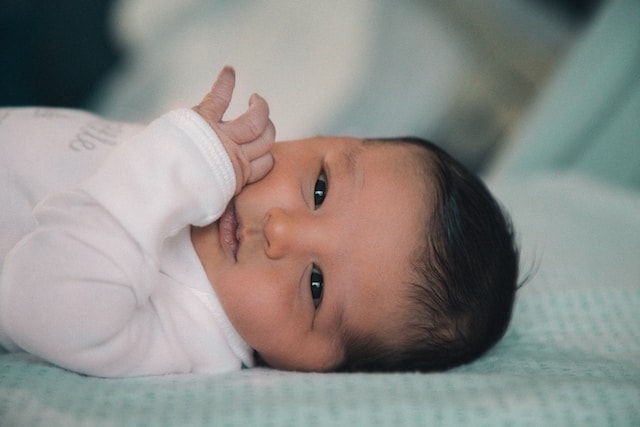Babies are known for their adorable and sometimes quirky movements. One movement that may catch your attention is when your baby raises their arms above their head.
While this may seem like a simple and harmless movement, it can actually indicate a lot about your baby’s development and well-being.
Understanding baby movements is important for parents and caregivers as it can help identify any potential issues or delays in development. Raising arms above the head is a common movement that babies make, especially during sleep or when being picked up.
However, if your baby is consistently raising their arms above their head and seems to be struggling with it, it may be a sign of a developmental issue or movement disorder.
Key Takeaways
- Raising arms above the head is a common movement in babies, but consistent struggles with this movement may indicate a developmental issue or movement disorder.
- Recognizing developmental milestones and identifying symptoms of movement disorders can help parents and caregivers address any potential issues early on.
- Consulting with a pediatrician and utilizing therapeutic interventions can help diagnose and treat conditions related to baby movements.
Understanding Baby Movements
Babies are constantly moving and exploring their environment. They may raise their arms above their head, kick their legs, or turn their head to look at something interesting.
Understanding baby movements can help parents and caregivers provide appropriate support and stimulation for their development.
1. Motor Skills Development
Motor skills development refers to the ability to control movements of the body. Babies develop motor skills in a predictable sequence, starting with gross motor skills such as head control and rolling over, and progressing to fine motor skills such as grasping and manipulating objects.
2. Reflexes and Reactions
Reflexes are automatic movements in response to a stimulus. For example, the Moro reflex is a startle reflex where a baby will throw their arms out and then bring them back in when they hear a loud noise.
Reactions are movements that are learned through experience. For example, a baby may learn to lift their arms when they want to be picked up.
3. Posture and Mobility
Posture refers to the alignment of the body, while mobility refers to the ability to move around. Babies develop their posture and mobility through a combination of muscle strength, coordination, and balance.
For example, a baby may start by sitting with support, then progress to sitting independently, and eventually learn to crawl and walk.
Overall, understanding baby movements can help parents and caregivers provide appropriate support and stimulation for their development. By providing opportunities for babies to explore and move, parents can help them develop their motor skills, reflexes, reactions, posture, and mobility.
Recognizing Developmental Milestones
Recognizing developmental milestones is an important aspect of caring for a growing baby. As babies develop, they reach certain milestones that indicate their growth and development.
Two of these milestones are sitting and rolling, and grasping and arm flapping.
1. Sitting and Rolling
Sitting is one of the first major milestones that babies reach. At around 6 months of age, babies are typically able to sit up on their own. They may need some support at first, but eventually, they will be able to sit up without any assistance.
Rolling is another important milestone that babies reach at around 4-6 months of age. Rolling is an important precursor to crawling, and it also helps babies develop their core muscles.
2. Grasping and Arm Flapping
Grasping is another important milestone that babies reach at around 3-4 months of age. At this age, babies are able to grasp objects with their hands, and they may even be able to transfer objects from one hand to the other.
Arm flapping is another common behavior that babies exhibit at around 3-4 months of age. While arm flapping may seem like a random behavior, it is actually an important part of a baby’s motor development.
Overall, recognizing developmental milestones is an important part of caring for a growing baby. By understanding the milestones that babies reach, caregivers can provide appropriate support and stimulation to help their babies grow and develop.
Identifying Symptoms of Movement Disorders
Movement disorders can affect babies in different ways and can be caused by various factors. Identifying symptoms of movement disorders in babies can help parents and caregivers seek appropriate medical attention and treatment.
Here are some common symptoms of movement disorders in babies:
1. Myoclonus
Myoclonus is a movement disorder that causes sudden, involuntary jerking of muscles or groups of muscles. It can affect any part of the body, including the arms, legs, and face. In babies, myoclonus can be a symptom of a neurological condition or a metabolic disorder.
It can also be caused by medications or infections. Parents may notice their baby’s arms suddenly jerking above their head or their legs twitching while sleeping.
2. Hypotonia and Hypertonia
Hypotonia and hypertonia are two opposite conditions that affect muscle tone. Hypotonia is a condition where the muscles are too relaxed, while hypertonia is a condition where the muscles are too tense. Both conditions can affect a baby’s ability to move and can be a symptom of a neurological disorder.
Parents may notice their baby’s arms hanging limply by their sides or their arms and legs stiffening and resisting movement.
2. Epilepsy
Epilepsy is a neurological disorder that causes seizures. Seizures can affect different parts of the body, including the arms and legs. In babies, seizures can be difficult to detect because they may not show the classic signs of convulsions.
Instead, parents may notice their baby’s arms suddenly stiffening or jerking above their head, or their baby staring blankly for a few seconds.
In conclusion, identifying symptoms of movement disorders in babies can help parents and caregivers seek appropriate medical attention and treatment. Myoclonus, hypotonia, hypertonia, and epilepsy are just a few examples of movement disorders that can affect babies.
If parents notice any unusual movements or behaviors in their baby, they should seek medical advice from a healthcare professional.
Addressing Birth Complications
When it comes to raising a baby, there are many challenges that new parents may face. Some babies may be born with complications that require special attention and care. Here are some of the most common birth complications and how to address them:
1. Low Birth Weight
Low birth weight is a common complication in newborns, and it can be caused by a variety of factors, including premature birth, poor maternal nutrition, and smoking during pregnancy. Babies with low birth weight may have trouble gaining weight and may be more susceptible to infections.
To address low birth weight, parents should work with their healthcare provider to develop a feeding plan that meets the baby’s nutritional needs. This may involve supplementing with formula or pumping breast milk to ensure the baby is getting enough calories.
Parents should also take steps to prevent infections by washing their hands frequently and keeping the baby away from sick people.
2. Birth Injury
Birth injuries can occur during delivery and can range from minor bruises to more serious conditions like cerebral palsy. Some common birth injuries include broken bones, nerve damage, and brain damage.
To address birth injuries, parents should work closely with their healthcare provider to develop a treatment plan. This may involve physical therapy, medication, or surgery, depending on the severity of the injury.
Parents should also take steps to prevent further injury by ensuring the baby is properly supported and avoiding activities that could exacerbate the injury.
3. Infections and Strokes
Infections and strokes can also occur in newborns and can have serious consequences if left untreated. Common infections in newborns include meningitis, sepsis, and pneumonia. Strokes can occur due to a lack of oxygen during delivery or as a result of an infection.
To address infections and strokes, parents should work closely with their healthcare provider to monitor the baby’s symptoms and develop a treatment plan. This may involve antibiotics, antiviral medication, or other treatments depending on the specific infection or condition.
Parents should also take steps to prevent infections by ensuring the baby is properly vaccinated and avoiding contact with sick people.
Overall, addressing birth complications requires close collaboration between parents and healthcare providers. By working together, parents can ensure their baby receives the care and attention they need to thrive.
Diagnosing and Treating Conditions
1. Cerebral Palsy
Cerebral palsy is a disorder that affects movement and muscle tone. It is usually diagnosed in early childhood and can result from brain damage that occurs before, during, or shortly after birth. Symptoms of cerebral palsy can include difficulty with coordination, muscle stiffness, and weakness.
Treatment options for cerebral palsy may include physical therapy, occupational therapy, and medication.
2. Brain Damage
Brain damage can occur due to a variety of factors, including trauma, infection, or lack of oxygen. Symptoms of brain damage can vary depending on the location and severity of the injury, but may include difficulty with movement, speech, or memory.
Treatment options for brain damage may include surgery, medication, and rehabilitation therapy.
3. Digestive Problems
Digestive problems can occur in infants and children for a variety of reasons, including food allergies, infections, or structural abnormalities. Symptoms of digestive problems can include vomiting, diarrhea, and abdominal pain.
Treatment options for digestive problems may include dietary changes, medication, and surgery.
In order to diagnose and treat these conditions, it is important to consult with a healthcare professional. They can perform a physical exam, order diagnostic tests, and develop a treatment plan tailored to the individual’s specific needs.
It is important to follow their recommendations and seek medical attention if symptoms persist or worsen.
Therapeutic Interventions
1. Physical Therapy
Physical therapy is often recommended for infants with raised arms as it can help improve muscle strength, range of motion, and overall development. A physical therapist will work with the baby to perform exercises that target specific muscle groups and promote movement.
These exercises may include stretching, massage, and other techniques.
Physical therapy can also help with the prevention of contractures, which can occur when muscles become shortened and tight due to lack of use. Contractures can cause permanent damage if left untreated, making physical therapy an important part of treatment for infants with raised arms.
2. Botulinum Toxin Therapy
Botulinum toxin therapy, also known as Botox therapy, is a treatment option for infants with raised arms caused by muscle spasticity. This therapy involves injecting a small amount of Botox into the affected muscle, which helps to relax it and reduce spasticity.
Botox therapy can be effective in reducing muscle spasticity and improving range of motion. However, it is not a permanent solution and may need to be repeated over time.
3. Surgery
In some cases, surgery may be necessary to treat raised arms in infants. Surgery may be recommended if other treatments have not been successful or if the condition is severe.
Surgical options may include lengthening or releasing the affected muscle, or transferring a tendon to a different location to improve function. Surgery is typically reserved for cases where other treatment options have not been effective.
Overall, therapeutic interventions such as physical therapy, botulinum toxin therapy, and surgery can be effective in treating raised arms in infants. It is important to work closely with a healthcare provider to determine the best treatment plan for each individual case.
Role of Pediatrician and Community
1. Regular Check-ups
Pediatricians play a crucial role in monitoring a baby’s growth and development. During regular check-ups, a pediatrician will assess the baby’s motor skills, including their ability to raise their arms above their head.
If a baby is not meeting developmental milestones, the pediatrician may recommend further evaluation or intervention.
2. Community Support
In addition to regular check-ups with a pediatrician, community support can also play a role in promoting healthy development in babies. This can include educational programs for parents and caregivers, as well as access to resources such as physical therapy or occupational therapy if needed.
Awareness of the importance of early intervention and support for babies who may be experiencing developmental delays is crucial. By working together, pediatricians and the community can help ensure that all babies have the best possible start in life.
Related Posts:
Frequently Asked Questions
When do babies have control of their hands?
Babies begin to gain control of their hands and fingers around 3 months of age. They will start to reach for objects and grasp them with their fingers.
What age do babies raise their arms?
Babies can start raising their arms above their head as early as 2 months of age. This is a normal part of their development and allows them to explore their body and the space around them.
Why does my baby raise her arms up?
Babies may raise their arms up for a variety of reasons, such as exploring their body, reaching for objects, or expressing excitement or frustration. It is a normal part of their development and should not be a cause for concern.
What does it mean when baby flails arms?
Flailing arms can be a sign of overstimulation or discomfort in babies. It may also indicate that they are trying to communicate a need, such as hunger or a diaper change. It is important to observe their behavior and respond accordingly.
What is torticollis baby?
Torticollis, also known as “wry neck,” is a condition where a baby’s neck muscles are tight or shortened on one side, causing their head to tilt to one side. This can affect their ability to move their head and neck, and may require physical therapy to correct.
Why do babies lift their legs up while sleeping?
Babies may lift their legs up while sleeping as a way to self-soothe and feel more comfortable. It can also be a sign of gas or discomfort in their digestive system. Parents can try gently massaging their baby’s tummy or changing their position to help alleviate any discomfort.

Iesha is a loving mother of 2 beautiful children. She’s an active parent who enjoys indoor and outdoor adventures with her family. Her mission is to share practical and realistic parenting advice to help the parenting community becoming stronger.



